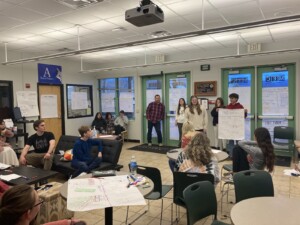Excerpt: Student Centered School Improvement
Key Points
-
Quality education equips young people with knowledge and necessary skills and helps them develop positive values, ideas and morals so they are ready to take the responsibilities and challenges of adulthood.
-
Below is an excerpt from the introduction of the book Student-Centered School Improvement: Identifying Systemic Changes Essential for Success.

By: Aimee Evan
Below is an excerpt from the introduction of the book Student-Centered School Improvement: Identifying Systemic Changes Essential for Success.
How do we improve the lives of humans?
As a parent, teacher, school leader, and researcher, I have seen how a poor education holds children back and how a great education propels them forward. Working in schools, I am in awe of the brilliance, creativity, and ambition of young people and strongly believe all children deserve the opportunity to realize their fullest potential through a dynamic and challenging learning environment.
I want to share how we can accomplish meeting the variety of students’ needs in education if we redesign the way we identify schools -early when showing distress- and restructure the system of support around them to be more focused on student needs.
In this book, I arm you with the tools needed, drawing on cutting-edge research on how to identify schools earlier for support, as well as the real-world experiences of a wide range of “school improvers”—in education from Governors, Secretary of Education, and State Education “Chiefs” to parents, students and teachers. This book will show how an aligned, systemic approach to early identification and support of issues in school can help improve the educational sector across the U.S. In this book, I help you as the reader:
- Reflect on the outcomes of our current educational system (see why things need to change)
- Envision what models of where our educational system is/should be going; what “effective” looks like so you can see for yourself what will be needed to get there; and how change can unfold over time (see what has to change)
- Build using resources to get there: skills, competencies, confidence (see how they have to change)
To do so, this book is organized into two parts. In Part I, you’ll take a look at current trends of student trajectory and impact stemming from the educational reforms enacted since 1965 to unpack why we need a new philosophy for school improvement and why now. Part I helps us reflect by giving us a better sense of how to move forward, by first taking a step back into how we got to this moment in educational improvement. You’ll examine our history of accountability, and the toll accountability has taken on expectations for students (Chapter 2), and the history of tactics for school improvement (Chapter 3) and the impact school improvement has taken on teachers (Chapter 4). Finally, Chapter 5 presents you with a crossroads moment in our education system. Which way you choose to proceed is up to you.
Quality education equips young people with knowledge and necessary skills and helps them develop positive values, ideas and morals so they are ready to take the responsibilities and challenges of adulthood.
Aimee Evan
In Part II, I outline an integrated framework of what is needed and how to design a system of preventative school improvement that centers around what is most impactful for students. I introduce the idea of using an early warning system, and how to identify schools in early stages of decline, instead of waiting until schools need comprehensive improvement before we intervene (Chapter 6). Schools identified earlier for support are much more likely to stop the downward spiral into failure. The improvement work is faster, less resource intensive, and more likely to be successful and equip you with the tools to do so (Chapter 7). You’ll explore how to authentically engage families and communities (Chapter 8). I show you meaningful models of student centered learning in order to propel them forward (Chapter 9). Our country’s projected demographics will only continue to change. Unless we change to meet these new needs, we will falter even further. In Chapter 10, I unpack what it means to support teachers, as they can be the sirens of a school struggling. Finally, in Chapter 11, you’ll explore the systems alignment needed to ensure the support to schools are provided. For this work to reach its full potential to strengthen the education sector, a systemic approach is needed. It is not enough to focus solely on engaging change only at the school level, intervention must be integrated throughout the education pipeline to ensure systemic, and therefore, sustainable improvement. Chapter 11 will show you how.
Education is a major driving force of development in any modern society. Quality education equips young people with knowledge and necessary skills and helps them develop positive values, ideas and morals so they are ready to take the responsibilities and challenges of adulthood. It also plays a vital role in promoting the intellectual, social, economic, cultural, and civic development. The ability of a nation to sustain this process is key to its development, economic prosperity and the well-being of its citizens.
We are on the precipice of a turning point in our society and education is more important than ever.
Until we rethink the purpose of accountability, the impact of our school improvement mantra of “wait to fail.” Education truly saves lives, but if we cannot guarantee all of our students have the opportunity to reach their full potential – if only students coming from the right families, growing up in the right neighborhoods, who know the right people are the only ones with a right to a good education, we’ll soon be living in the wrong country.
I hope this book will offer you transformative, yet practical ways to leverage what has worked and dismantle what has not in improving our educational system for all students. I am excited you are joining this journey and wish you well as you embrace a new way of envisioning a high quality of education for all. Our children, and our country, depend on it.
Aimee Evan is the Senior Research Associate and School Improvement Specialist at WestEd.





0 Comments
Leave a Comment
Your email address will not be published. All fields are required.